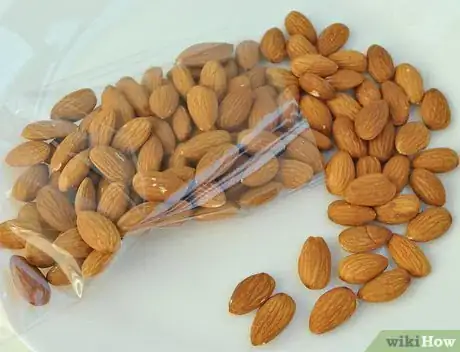This article was co-authored by wikiHow Staff. Our trained team of editors and researchers validate articles for accuracy and comprehensiveness. wikiHow's Content Management Team carefully monitors the work from our editorial staff to ensure that each article is backed by trusted research and meets our high quality standards.
This article has been viewed 52,801 times.
Learn more...
Activating almonds essentially is just soaking the nuts in water for a few hours, after which you can eat them raw or cook them. Doing so makes the almonds begin to sprout, which causes the enzymes inside of the almonds to break down. In their sprouting state, all of the proteins, vitamins, minerals, and fatty acids are activated, which means your body can absorb them all and get the most out of this tasty food, whether you're just eating them as a snack or adding them to a meal. Inactivated almonds, whether they are raw or roasted, contain enzyme inhibitors that prevent your digestive system from extracting all of their valuable nutrients.
Steps
Soaking the Almonds
-
1Purchase raw almonds from your local grocery store. If your local grocery store doesn’t carry raw almonds, check your local health food store. You can either purchase non-organic or organic raw almonds.[1]
- Make sure they are unsalted and not roasted.
-
2Pour 2 to 4 cups (280 to 560 grams) of raw almonds in a large bowl. Use a bowl that is large enough to hold the almonds and the water to cover them. Whether you use 2 or 4 cups depends on how many almonds you want to activate.[2]Advertisement
-
3Cover the raw almonds with water. Pour enough water into the bowl until all of the almonds are submerged by 1.5 inches (3.8 cm) of water. Add a half of a tablespoon to a tablespoon (9 to 18 grams) of sea salt to the bowl. Use a spoon to stir the almonds, salt, and water together.[3]
- The salt makes the almonds taste better and helps to deactivate the enzyme inhibitors.
-
4Soak the almonds for 7 to 12 hours. Cover the bowl with a clean cloth. Set the bowl aside on a counter. Let the almonds soak overnight, or for 7 to 12 hours.[4]
-
5Drain and rinse the almonds. Once the almonds have finished soaking, pour them into a sieve to drain them. Hold the sieve under running water to rinse the almonds of salt and other debris.[5]
-
6Eat the almonds raw. You can eat the almonds raw without roasting them. You can soak them or add them to other foods, such as putting them in a trail mix.
- However, if you like the taste and crunch of dry almonds, then try roasting them in an oven or drying them in a dehydrator.[6]
Drying the Almonds
-
1Season the almonds with salt or a dry mix if you want to. Fill the bottom of a small bowl with salt, cinnamon sugar, Cajun seasoning, or one of your favorite dry mixes. Toss the almonds in the dry mix until they are evenly coated.[7]
-
2Lay them on a baking sheet. Line a baking sheet with parchment paper. Pour the almonds onto the parchment paper. Spread them out evenly on the baking sheet.[8]
- The almonds should be lying flat, and not overlapping each other, on the parchment paper.
-
3Cook the almonds in a 150 °F (66 °C) oven for 12 to 24 hours. If your oven’s lowest temperature setting is above 150 °F (66 °C), then bake them on the lowest setting for 8 to 10 hours. The almonds are done when they taste dry, or when their centers are dry and not wet and soft.[9]
- Make sure your almonds are completely dry before storing them. If they are not completely dry, mold will grow on them, even if they are stored in an airtight container.
-
4Use a dehydrator to dry them if you have one. Set your dehydrator to 150 °F (66 °C). Lay the almonds in a single layer on the dehydrator trays. Place the almonds in the dehydrator for 12 to 24 hours, or until crispy.[10]
- You do not need to line the dehydrator trays with parchment paper.
-
5Store the almonds in an airtight container. Let the almonds cool to room temperature, about an hour. Place the almonds in a mason jar, or a plastic or glass container that is airtight. Store them in your pantry for 1 month.[11]
- You can also store them in the fridge for up to 6 months.
Community Q&A
Did you know you can get answers researched by wikiHow Staff?
Unlock staff-researched answers by supporting wikiHow
-
QuestionAre almonds healthy?
 wikiHow Staff EditorThis answer was written by one of our trained team of researchers who validated it for accuracy and comprehensiveness.
wikiHow Staff EditorThis answer was written by one of our trained team of researchers who validated it for accuracy and comprehensiveness.
Staff Answer wikiHow Staff EditorStaff Answer
wikiHow Staff EditorStaff Answer -
QuestionDo I have to activate almonds? I've never bothered before.
 wikiHow Staff EditorThis answer was written by one of our trained team of researchers who validated it for accuracy and comprehensiveness.
wikiHow Staff EditorThis answer was written by one of our trained team of researchers who validated it for accuracy and comprehensiveness.
Staff Answer wikiHow Staff EditorStaff AnswerIn spite of the current paleo diet insistence that nuts need to be activated to be beneficial and to rid them of phytates, you do not have to activate almonds to still get health benefits. Phytates actually have some health benefits, like being anti-inflammatory and providing antioxidants. If you're already eating a varied, healthy diet, unactivated almonds are fine, especially as our bodies can break down phytates anyway. However, you might prefer the softer, sweeter texture of soaked almonds, especially for certain paleo or other dishes.
wikiHow Staff EditorStaff AnswerIn spite of the current paleo diet insistence that nuts need to be activated to be beneficial and to rid them of phytates, you do not have to activate almonds to still get health benefits. Phytates actually have some health benefits, like being anti-inflammatory and providing antioxidants. If you're already eating a varied, healthy diet, unactivated almonds are fine, especially as our bodies can break down phytates anyway. However, you might prefer the softer, sweeter texture of soaked almonds, especially for certain paleo or other dishes. -
QuestionHow do you make almond milk?
 wikiHow Staff EditorThis answer was written by one of our trained team of researchers who validated it for accuracy and comprehensiveness.
wikiHow Staff EditorThis answer was written by one of our trained team of researchers who validated it for accuracy and comprehensiveness.
Staff Answer wikiHow Staff EditorStaff AnswerAlmond milk can be made after a long soak or more quickly through an immersion process. To find both methods, check out the wikiHow: How to Make Almond Milk.
wikiHow Staff EditorStaff AnswerAlmond milk can be made after a long soak or more quickly through an immersion process. To find both methods, check out the wikiHow: How to Make Almond Milk.
References
- ↑ https://www.care.com/c/stories/8097/how-to-activate-almonds/
- ↑ http://www.easypeasyorganic.com/2011/01/ready-set-activate-activated-almonds.html
- ↑ https://blog.radiantlifecatalog.com/bid/69542/That-s-Nuts-A-Complete-Guide-to-Soaking-Nuts-and-Seeds
- ↑ https://blog.radiantlifecatalog.com/bid/69542/That-s-Nuts-A-Complete-Guide-to-Soaking-Nuts-and-Seeds
- ↑ https://www.care.com/c/stories/8097/how-to-activate-almonds/
- ↑ http://www.easypeasyorganic.com/2011/01/ready-set-activate-activated-almonds.html
- ↑ http://www.easypeasyorganic.com/2011/01/ready-set-activate-activated-almonds.html
- ↑ http://www.easypeasyorganic.com/2011/01/ready-set-activate-activated-almonds.html
- ↑ http://www.easypeasyorganic.com/2011/01/ready-set-activate-activated-almonds.html
About This Article
To activate raw almonds, place 2 to 4 cups of almonds into a large bowl. Next, pour water into the bowl until the almonds are submerged by 1.5 inches of water. Then, add 1 tablespoon of sea salt and stir it together with the almonds and water. Cover and soak the almonds for 7 to 12 hours, then drain and rinse them under running water. Eat the almonds raw, or dry them in the oven or a food dehydrator. For instructions on seasoning and drying your almonds, read on.




























































